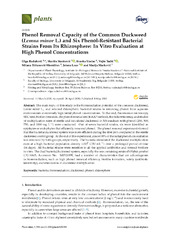Приказ основних података о документу
Phenol Removal Capacity of the Common Duckweed (Lemna minor L.) and Six Phenol-Resistant Bacterial Strains From Its Rhizosphere: In Vitro Evaluation at High Phenol Concentrations
| dc.creator | Radulović, Olga | |
| dc.creator | Stanković, Slaviša | |
| dc.creator | Uzelac, Branka | |
| dc.creator | Tadić, Vojin | |
| dc.creator | Trifunović-Momčilov, Milana | |
| dc.creator | Lozo, Jelena | |
| dc.creator | Marković, Marija | |
| dc.date.accessioned | 2020-05-21T07:13:45Z | |
| dc.date.available | 2020-05-21T07:13:45Z | |
| dc.date.issued | 2020 | |
| dc.identifier.issn | 2223-7747 | |
| dc.identifier.uri | https://www.mdpi.com/2223-7747/9/5/599 | |
| dc.identifier.uri | https://radar.ibiss.bg.ac.rs/handle/123456789/3676 | |
| dc.description.abstract | The main topic of this study is the bioremediation potential of the common duckweed, Lemna minor L., and selected rhizospheric bacterial strains in removing phenol from aqueous environments at extremely high initial phenol concentrations. To that end, fluorescence microscopy, MIC tests, biofilm formation, the phenol removal test (4-AAP method), the Salkowski essay, and studies of multiplication rates of sterile and inoculated duckweed in MS medium with phenol (200, 500, 750, and 1000 mg L−1) were conducted. Out of seven bacterial strains, six were identified as epiphytes or endophytes that efficiently removed phenol. The phenol removal experiment showed that the bacteria/duckweed system was more efficient during the first 24 h compared to the sterile duckweed control group. At the end of this experiment, almost 90% of the initial phenol concentration was removed by both groups, respectively. The bacteria stimulated the duckweed multiplication even at a high bacterial population density (>105 CFU mL−1) over a prolonged period of time (14 days). All bacterial strains were sensitive to all the applied antibiotics and formed biofilms in vitro. The dual bacteria/duckweed system, especially the one containing strain 43-Hafnia paralvei C32-106/3, Accession No. MF526939, had a number of characteristics that are advantageous in bioremediation, such as high phenol removal efficiency, biofilm formation, safety (antibiotic sensitivity), and stimulation of duckweed multiplication. | en |
| dc.publisher | MDPI AG | |
| dc.relation | info:eu-repo/grantAgreement/MESTD/inst-2020/200007/RS// | |
| dc.relation | Ministry of Education, Science, and Technological Development of the Republic of Serbia (451-03-68/2020-14/200178) | |
| dc.rights | openAccess | |
| dc.rights.uri | https://creativecommons.org/licenses/by/4.0/ | |
| dc.source | Plants | |
| dc.subject | Bacteria | |
| dc.subject | Bioremediation | |
| dc.subject | Duckweed | |
| dc.subject | Phenol | |
| dc.subject | Rhizosphere | |
| dc.title | Phenol Removal Capacity of the Common Duckweed (Lemna minor L.) and Six Phenol-Resistant Bacterial Strains From Its Rhizosphere: In Vitro Evaluation at High Phenol Concentrations | en |
| dc.type | article | en |
| dc.rights.license | BY | |
| dcterms.abstract | Узелац, Бранка; Тадић, Војин; Трифуновић-Момчилов, Милана; Радуловић, Олга; Станковић, Славиша; Лозо, Јелена; Марковић, Марија; | |
| dc.rights.holder | © 2020 by the authors. Licensee MDPI, Basel, Switzerland. | |
| dc.citation.issue | 5 | |
| dc.citation.volume | 9 | |
| dc.identifier.doi | 10.3390/plants9050599 | |
| dc.identifier.pmid | 32397144 | |
| dc.identifier.scopus | 2-s2.0-85084434944 | |
| dc.identifier.wos | 000542286900078 | |
| dc.citation.apa | Radulović, O., Stanković, S., Uzelac, B., Tadić, V., Trifunović-Momčilov, M., Lozo, J., et al. (2020). Phenol Removal Capacity of the Common Duckweed (Lemna minor L.) and Six Phenol-Resistant Bacterial Strains From Its Rhizosphere: In Vitro Evaluation at High Phenol Concentrations. Plants, 9(5), 599. | |
| dc.citation.vancouver | Radulović O, Stanković S, Uzelac B, Tadić V, Trifunović-Momčilov M, Lozo J, Marković M. Phenol Removal Capacity of the Common Duckweed (Lemna minor L.) and Six Phenol-Resistant Bacterial Strains From Its Rhizosphere: In Vitro Evaluation at High Phenol Concentrations. Plants. 2020;9(5):599. | |
| dc.citation.spage | 599 | |
| dc.type.version | publishedVersion | |
| dc.identifier.fulltext | https://radar.ibiss.bg.ac.rs/bitstream/id/6192/Plants_2020_9_5_599.pdf | |
| dc.citation.rank | M21 |

